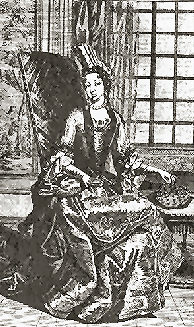
There is much in the literature about the history of this game. The copy of the French engraving on the left of Princess de Soubise illustrating her playing the game, dates from 1697. Pieter van Delft & Jack Botermans (Creative Puzzles of the World, New York: Harry N. Abrams, Inc., 1978, page 170) indicate that the game was well-known by the time the engraving appeared, having been reputedly been invented years earlier by a French nobleman while imprisoned alone in a cell in the Bastille. Out of boredom, this nobleman is said to have devised the game using a Fox & Geese Board.
The Fox & Geese Board was used prior to the 14th century for a variety of board games in Northern Europe since the time of the Vikings. There is doubt about the invention of Peg Solitaire by the French nobleman, since the famous German mathematician Leibnitz wrote about the game and described it in 1710.
Be that as it may, here are some examples of the game from the Museum collection.
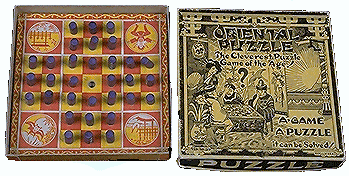
Puzzle Pegs: A late 19th century commercial version of this game was purchased by the Museum in 1981. The 15cm square 33 "cell" board is typical of this game. There are 32 wooden pegs 2cm long x .75cm diameter positioned as shown in the photo. The object of all of these puzzles is to remove all pegs except one, leaving the last peg in the center hole. There are a variety of ways to play - usually multiple jumps forward or backward over pegs when there are blank holes between pegs. Using other configurations on the board (a triangle, a cross, etc.) enables the devising of a variety of puzzles on the same board.
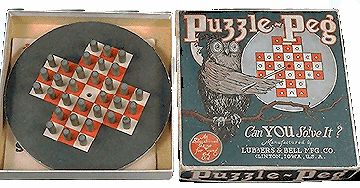
Puzzle-Peg: A 1929 commercial version of the game manufactured by Lubbens & Bell Manufacturing Company, Clinton, Iowa, was purchased by the Museum in 1981. A similar game from this manufacturer is pictured and discussed in Jerry Slocum & Jack Botermans, Puzzles Old & New, Seattle: University of Washington Press, 1992, page 118. While the box is 16.5cm 17cm long x 16.75cm wide x 3cm high, the playing surface (made of pressed cardboard) is 16.5cm in diameter. The wooden pegs are 2.5cm high x .5cm in diameter. A booklet with a variety of puzzles that can be played on this board is included in the box.
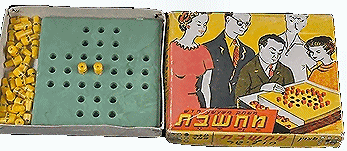
Solitaire: Purchased by the Museum in 1972 and manufactured about that time in Israel, instructions are printed in Hebrew inside the box lid. The plastic 33 holed board is 9.9cm square x 1.2cm thick. There are 33 1.4cm high plastic pegs, which taper from .7cm at the top to .4cm at the bottom of each peg. Play of this version is identical to the previous examples.
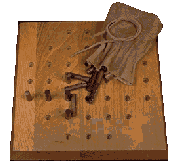
Teasing Pegs: Purchased in 1974 from Piet Hein & Skjode, Denmark, this elegant teak wood version has an alternative name: French Solitaire The board tapers from 25cm square at the bottom to 23.5cm at the top, and is 2.5cm thick. The board sits on four rubber feet stapled to the bottom. 37 holes are drilled into the top to enable a number of games. The 34 wooden pegs are 3.6cm long x .9cm in diameter. With the board is a 13.8cm long x 10cm wide suede and leather bag with a 41cm long tie used to hold the pegs when the game is stored. Stapled to the bottom of the board are instructions in English, Danish, and Swedish.
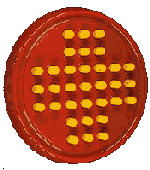
Hi-Q: Donated to the Museum in 1981 and marketed by Kohner Brothers, New York, this version seemed to stimulate a new popular interest in the puzzle at that time. This version is no different
than all of the previous versions and can trace it's lineage back to at least 16th century France. The one difference is that this board is "round"
and both it and the hollow yellow pegs are made of plastic.
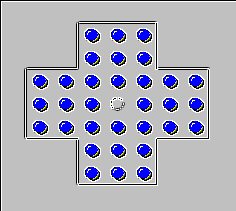
Pegged: Microsoft made this microcomputer version of the same game available with it's earlier versions of the Windows operating system. This "screen copy" of the gameboard is from a 1992 version of Windows. Using a mouse, a player moves the pegs by pointing the mouse cursor. The game instructions are similar to all the non-computerized versions of the game. In addition to playing the traditional game of "Solitaire" on the full board, a player can choose other configurations for play, such as an arrow, a pyramid, a diamond, a plus sign, and more. As in a "manual" game, the computer will let the player "backup" a move, or ask for help.
NOTE: This page was originally created and posted on the Web on October 6, 1997. Subsequently it has been modified and periodically updated. Last update April 11, 2010